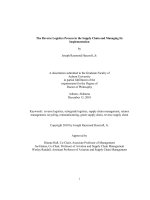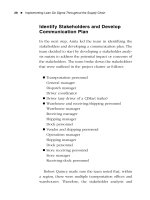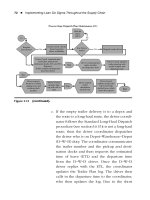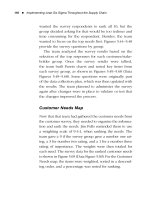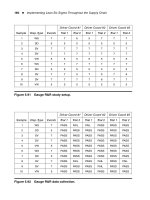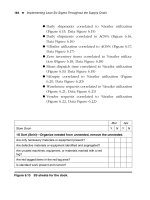bookflarenet rfid for the supply chain and op copy
Bạn đang xem bản rút gọn của tài liệu. Xem và tải ngay bản đầy đủ của tài liệu tại đây (1.67 MB, 207 trang )
lOMoARcPSD|3280145
[Bookflare.net] - RFID for the Supply Chain and Op - Copy
Operations Management (University of Dhaka)
StuDocu is not sponsored or endorsed by any college or university
Downloaded by Pham Quang Huy ()
lOMoARcPSD|3280145
Supply and Operations
Management Collection
M. Johnny Rungtusanatham and Joy M. Field,
Editors
RFID for the
Supply Chain
and Operations
Professional
Second Edition
Pamela J. Zelbst
Victor E. Sower
Downloaded by Pham Quang Huy ()
lOMoARcPSD|3280145
RFID for the Supply
Chain and Operations
Professional
Downloaded by Pham Quang Huy ()
lOMoARcPSD|3280145
Downloaded by Pham Quang Huy ()
lOMoARcPSD|3280145
RFID for the Supply
Chain and Operations
Professional
Second Edition
Pamela J. Zelbst and Victor E. Sower
Downloaded by Pham Quang Huy ()
lOMoARcPSD|3280145
RFID for the Supply Chain and Operations Professional, Second Edition
Copyright © Business Expert Press, LLC, 2016.
All rights reserved. No part of this publication may be reproduced,
stored in a retrieval system, or transmitted in any form or by any
means—electronic, mechanical, photocopy, recording, or any other
except for brief quotations, not to exceed 400 words, without the prior
permission of the publisher.
First published in 2012 by
Business Expert Press, LLC
222 East 46th Street, New York, NY 10017
www.businessexpertpress.com
ISBN-13: 978-1-63157-463-4 (paperback)
ISBN-13: 978-1-63157-464-1 (e-book)
Business Expert Press Supply and Operations Management Collection
Collection ISSN: 2156-8189 (print)
Collection ISSN: 2156-8200 (electronic)
Cover and interior design by Exeter Premedia Services Private Ltd.,
Chennai, India
Second edition: 2016
10 9 8 7 6 5 4 3 2 1
Printed in the United States of America.
Downloaded by Pham Quang Huy ()
lOMoARcPSD|3280145
Testimonials and Reviews
This book is the perfect primer for the uninitiated manager struggling
to understand RFID technology and how the technology can be used
to solve problems related to existing operations and supply chain management. The book is clear and concise and easily understood due to
the nontechnical approach adopted by the authors. The reader is introduced to RFID technology and instructed in the essentials and uses of
the technology. As the reader begins to appreciate the technology, the
authors provide the reader examples of solutions from all sectors. The
book is full of excellent examples of how the technology has been used
to solve existing problems. The reader will take away an understanding
of the capabilities of the technology to improve efficiency, effectiveness,
and responsiveness throughout product and service delivery processes. In
addition to the plethora of examples, the authors offer several in-depth
cases that illustrate successful applications of RFID technology in multiple settings. Once you understand the technology and its potential value,
the authors provide a step-by-step approach to successfully implementing RFID systems. Finally, they discuss the future of RFID technology
utilization. Essentially, the authors describe how RFID technology can be
used to strategic advantage.
Dr. Kenneth Green, Jr.
LeMay Professor of Technology
Southern Arkansas University
This book does a great job of introducing and explaining RFID technology, what makes it work, and the various settings and applications where
it can improve process flows. I am now more aware of where I might
encounter RFID technology, where and when it could be used to improve
processes, and how to add value to an organization.
Mr. Ken Holland
Continuous Improvement Program Manager, Supply Chain Operations
Freescale, Inc.
Downloaded by Pham Quang Huy ()
lOMoARcPSD|3280145
vi
TESTIMONIALS AND REVIEWS
If you are looking for an overview of radio-frequency identification
(RFID) technology, examples of how RFID is being used effectively
everywhere from hospitals to warehouses, and guidelines for implementing an RFID system, this is the book for you. The authors discuss the
benefits of RFID compared to similar technologies, and new applications
for its use in the future.
Inbound Logistics, January 2013, p. 274
Review of 1st Edition
Downloaded by Pham Quang Huy ()
lOMoARcPSD|3280145
Abstract
The quality and effectiveness of decisions made within an organization
and its supply chain depend on the accuracy and timeliness of the information on which they are based. Radio frequency identification (RFID)
is a technology that can provide more accurate information in near real
time and thus increase the quality and timeliness of decisions based
on that information. RFID systems are currently in use in areas such
as inventory management, process control, asset tracking and monitoring, and retail point of sale. Organizations that appropriately incorporate
RFID into their operations and information management systems have
increased their agility, effectiveness, and efficiency, resulting in organizational growth and increased profitability.
The appropriate utilization of RFID allows organizations to become
more agile, resulting in their ability to respond to customers more efficiently and effectively. Technology by itself does not result in improvements, and RFID is no exception. RFID is not a solution for every
problem. However, when coupled with other appropriate technologies
to address an appropriate objective, RFID can offer a variety of benefits
to businesses. The proper integration of RFID into the firm’s competitive plans and processes provides the ability to leverage the technology
for competitive advantage and results in increased performance for
organizations.
The intent of this book is to provide a sufficient discussion of RFID to
enable readers with no prior knowledge to develop a basic understanding
of the technology. The book discusses current applications and specific
examples of RFID usage taken from a variety of industries. The appropriate coupling of RFID with other technologies such as global positioning
systems (GPS), enterprise resource planning (ERP), and robotics is discussed as well as an overview of the RFID implementation process. This
book will help readers develop an understanding of the capability of the
technology to increase an organization’s customer responsiveness.
In the second edition, the discussion and examples have been updated
to reflect the rapid advancement in RFID technology. New case studies
and examples have been added along with a new chapter about RFID
technology and the Internet of Things.
Downloaded by Pham Quang Huy ()
lOMoARcPSD|3280145
viii
ABSTRACT
Keywords
agility, asset tracking, customer responsiveness, effectiveness, efficiency,
inventory management, real-time information systems, RFID implementation, RFID integration, RFID, timeliness
Downloaded by Pham Quang Huy ()
lOMoARcPSD|3280145
Contents
Abbreviations and Acronyms�������������������������������������������������������������������xi
Acknowledgments���������������������������������������������������������������������������������xiii
Chapter 1
Chapter 2
Chapter 3
Chapter 4
Chapter 5
Chapter 6
Chapter 7
Chapter 8
RFID Basics......................................................................1
RFID Technology Essentials ...........................................13
Uses of RFID Technology ...............................................33
RFID Is Not a Solution Waiting for a Problem ...............61
RFID and the Internet of Things ....................................77
Implementing RFID .......................................................91
Business Cases for RFID ...............................................105
Conclusions ..................................................................133
Appendix............................................................................................141
Notes..................................................................................................171
References ...........................................................................................177
Index .................................................................................................185
Downloaded by Pham Quang Huy ()
lOMoARcPSD|3280145
Downloaded by Pham Quang Huy ()
lOMoARcPSD|3280145
Abbreviations and Acronyms
ADC
AFSP
AIDC
AII
AIM
AIT
ANSI
aRFID
CNC
DARPA
DLA
DOD
EAS
EM
EMEA
EMV
EPC
ERP
ETSI
FCC
FLC
GPS
HF
IoT
ISO
ITV
KPI
automatic data capture
average factory selling price
automatic identification and data capture
auto ID infrastructure
Association for Automatic Identification and
Mobility
automatic information technology
American National Standards Institute
active radio frequency identification
computer numerical control
Defense Advanced Research Projects Agency
Defense Logistics Agency
Department of Defense
electronic article surveillance
event management
Europe, the Middle East, and Africa
Europay MasterCard Visa
Electronic Product Code
enterprise resource planning
European Telecommunications Standards
Institute
Federal Communications Commission
foldable large container
global positioning system
high frequency
Internet of Things
International Organization for Standardization
in-transit visibility
key performance indicators
Downloaded by Pham Quang Huy ()
lOMoARcPSD|3280145
xii
ABBREVIATIONS AND ACRONYMS
LCD
LF
LIMS
LPs
MHz
NIST
OR
PIN
POS
pRFID
RFID
ROI
SCM
SDK
UHF
USTRANSCOM
VMI
WIP
WMS
liquid crystal display
low frequency
laboratory information management system
long plays
megahertz
National Institute of Standards and Technology
operating room
personal identification number
point-of-sale
passive radio frequency identification
radio frequency identification
return on investment
supply chain management
software development kit
ultra high frequency
U.S. Transportation Command
vendor managed inventory
work-in-progress inventory
warehouse management system
Downloaded by Pham Quang Huy ()
lOMoARcPSD|3280145
Acknowledgments
The authors would like to acknowledge the peer reviewers of the manuscript for this book for their careful review and helpful comments:
• Dr. Kenneth Green, LeMay professor of technology, Southern
Arkansas University.
• Mr. Ken Holland, continuous improvement program
manager, supply chain operations, Freescale, Inc.
• Mr. George Dyche, product manager, Avery Dennison Corp.
• Mr. Steve Halliday, president of RAIN RFID.
• Mr. Glenn Outerbridge, CEO, Cybersoft North America.
We would like to thank Mr. Scott Isenberg, Business Expert Press
senior acquisitions editor, who provided us the opportunity to undertake
the writing of this book, and the editorial staff at Business Expert Press,
who worked with us to turn our manuscript into a finished product.
We would like to acknowledge and thank our students, Scott Golightly,
Hamid Bouaicha, and Devin McCullough for their contributions.
Lastly, we would like to acknowledge and thank our spouses, Charles
and Judy, for their support and encouragement during the process of
writing this book.
Downloaded by Pham Quang Huy ()
lOMoARcPSD|3280145
Downloaded by Pham Quang Huy ()
lOMoARcPSD|3280145
CHAPTER 1
RFID Basics
On a recent international trip, one of the authors parked in a long-term
parking facility near the airport that provides an identification card to
frequent parkers. When I arrived at the parking facility, I placed my card
against a reader. My name immediately appeared on an LCD display
and the attendant addressed me by name when she directed me to my
parking space. When returning, again I placed my card against a reader,
which displayed my name, the number of days I had been parked, and
the amount due. I paid my bill with my radio frequency identification
(RFID)-enabled smart card without speaking to an attendant. Any frequent parker specials were automatically credited to my bill. This was
made possible by a RFID tag embedded in the frequent parkers’ identification card. The only information recorded on the tag was a coded
number, which matched my name in a protected database.
When I went through the customs and border security stations at the
international airport, I was required to present my passport. The security
agent saw my picture on a monitor along with other identifying information to ensure that I am who I say I am, that I am using a valid passport,
and that I am not on any watch lists. This was made possible by the RFID
tag embedded in my passport.
When I checked into the hotel at my destination, I was given an
RFID-enabled card, which was the key to my room.
Upon returning home, I used the toll road out of the airport. An
E-ZPass transponder made it a breeze to speed through special lanes at the
toll booths. The toll authority registered my passage and automatically
billed my account. This too is made possible by an RFID tag, which is
embedded in the E-ZPass transponder.
Returning home I was greeted by Buddy, my dog. He has an RFID
chip implanted in his neck that is encoded with a number that is tied to
me in a database to identify him should he wander away from home.
Downloaded by Pham Quang Huy ()
lOMoARcPSD|3280145
2
RFID FOR THE SUPPLY CHAIN AND OPERATIONS PROFESSIONAL
The point is, believe it or not, you are already using RFID in your personal life. And each of these uses shows that businesses and governmental
agencies are also using RFID technology in order to increase efficiency,
gain a competitive advantage, increase security, or provide a service that is
better than could be otherwise provided.
Perhaps your organization has not explored the possibilities that RFID
technology has for improving performance and reducing cost. Perhaps
your competitors have.
Civilian businesses and the military are already using RFID. The
U.S. Army uses active RFID tags and a variety of sensors to monitor
temperature, shock, unauthorized entry, and various other critical data
for shipments to war zones. A tortilla manufacturer saved $700,000 in
packaging costs by tracking shipping containers using RFID.1 Marathon
Oil Company estimated that using RFID on its downhole drilling tools
would result in a savings of $17 million and improve operational safety of
its employees.2 Libraries are locating mis-shelved books simply by walking through the stacks with a portable RFID reader. Many organizations
are using RFID to simplify asset management. With RFID it is possible
to inventory all tagged assets in a room in a matter of minutes without
Figure 1.1 The value of RFID
Photograph courtesy of the Sower Business Technology Laboratory, College of Business
Administration, Sam Houston State University.
Downloaded by Pham Quang Huy ()
lOMoARcPSD|3280145
RFID BASICS
3
searching for a printed asset tag or bar code label seemingly affixed to the
most inaccessible spot on the asset.
The apparel industry is adopting this technology at an extremely fast
pace because RFID creates a real-time information environment allowing
for decision making using current information. “In recent years, a number of major retailers, including Macy’s, Kohl’s and Target, have begun
rolling out the technology chain-wide.”3 Using RFID, apparel inventories
can be monitored in the back room to track when an item arrives and
when it moves to the retailer’s floor. The real-time information system
can be extended to the sales floor to track inventory as it is purchased
so that information is updated automatically, keeping records current in
real time. Savvy retailers can use the information to identify which items
are moving quickly and keep the floor stocked so that sales can increase.
The technology can provide an advantage in vendor-managed inventory
(VMI) systems. Automated inventory management allows vendors to
have real-time information resulting in fewer stockouts. In addition, the
retailers’ cost for holding safety stock is reduced.
Health care organizations are also widely using RFID technologies.
Radio frequency identification technologies are being deployed
at numerous hospitals and clinics around the world to improve
asset-utilization rates; manage inventories of implants, drugs and
other high-value items; reduce the incidence of lost and stolen
equipment; improve patient flow; decrease medical errors; increase
hand-washing compliance; and achieve other significant benefits.4
Hospitals are using RFID, for example, to track specialized equipment, such as medication pumps, incubators, and wheelchairs, to assure
that surgical implements are all accounted for prior to suturing a surgical
patient in the operating room, to assist in the prevention of medication
errors, and to ensure that newborns are not removed from the nursery
without authorization. Nursing homes are monitoring the location of
Alzheimer’s patients with RFID.
RFID can be used as a stand-alone system or as a part of integrated
systems that may, for example, include bar codes, global positioning
software, environmental sensors, and many other parts. RFID has the
Downloaded by Pham Quang Huy ()
lOMoARcPSD|3280145
4
RFID FOR THE SUPPLY CHAIN AND OPERATIONS PROFESSIONAL
potential to add value by providing increased visibility to supply chains;
however, suppliers who are mandated to tag items for a retail customer
often find it difficult to see the value that RFID can bring internally.
Manufacturers are adopting the technology to track assets, materials, and
employees. When utilizing RFID for at least a 6-month period, manufacturers identified an average cycle-time reduction of 19 percent, a reduction in safety stock requirements of 27 percent, and an improvement in
changeover time of 24 percent. RFID can be integrated into just about
any industry and supply chain.5 The greatest value that the technology has
to offer is the flexibility to make decisions in real time.
Structure of the Book
This book provides readers who have little or no knowledge of RFID
technology, the basic background needed to begin considering how this
technology can contribute to the success of their organizations. It also
provides examples of how other organizations are using the technology. In
the second edition we have updated the text to reflect advances in RFID
technology since the first edition was published. We have also included
new examples, illustrations, and a new case study which illustrate the
wide variety of applications for the technology.
In Chapter 2, we provide the basic technical details about RFID and
how it works. A basic knowledge of the technical aspects of RFID is essential in order to understand its capabilities and how they might be part of
the solution to problems you are trying to address. This knowledge also is
essential for being able to communicate better with manufacturers, suppliers, systems integrators, consultants, and others who might be essential
to enabling your organization to take advantage of the technology.
Later in the book, we bring you up to date on the state of the technology, its current applications, and future possibilities. Chapter 5 is an
entirely new chapter for the second edition entitled “RFID and the Internet of Things.” Of course there are few boundaries on the uses of RFID,
so if you do not see a discussion of the application you have in mind, then
yours might be the next innovative use of the technology, which means
you could create an advantage over others in your industry who have not
yet conceived of that application.
Downloaded by Pham Quang Huy ()
lOMoARcPSD|3280145
RFID BASICS
5
We include in the book a selection of five business cases that provide
some detail about actual organizations that have developed applications
for RFID. The cases provide insight into how a diverse group of organizations went from idea to implemented process and the effect the new
process had on organizational performance. We then discuss the process
of implementation and what is next for RFID in the coming years.
Hanns-Christian L. Hanebeck’s essay (immediately following this
section) addresses the value of RFID. Over the past two decades, Chris
has focused his career on management consulting, strategy development,
and technology innovation. He currently serves as chief operating officer
at GT Supply Chain where his responsibilities include the design and
implementation of company strategies as well as handling of key account
customers and management of supply chain and procurement personnel.
Prior to this position, Chris served as chief operating officer at Revere
Security where he developed innovative encryption technologies for active
and passive RFID tags. Previously, Chris ran his own management consulting firm, led the industrial sector consulting group for RFID at IBM
and spent 6 years in several executive roles at GlobeRanger, an innovative
software startup for RFID Edgeware. Chris has successfully completed
business process optimization and software implementation projects for
over 60 clients on 3 continents exceeding $65 million in overall budget
responsibility.
He has authored over 60 publications, presented at over 100 major
conferences, and has been awarded 5 U.S. patents for highly innovative
RFID and material tracking applications. He holds an MBA from the
University of Saarbrucken in Germany and teaches supply chain strategy at the University of North Texas. He can be reached at hhanebeck@
yahoo.com.
The Value of RFID
by Hanns-Christian L. Hanebeck,
Chief Operating Officer, GT Supply Chain
The auto-ID industry has matured considerably over the past few
years. We have seen many innovative applications, specifically for
Downloaded by Pham Quang Huy ()
lOMoARcPSD|3280145
6
RFID FOR THE SUPPLY CHAIN AND OPERATIONS PROFESSIONAL
RFID, in fields that we did not even begin to imagine in the late-1990s
when ultra-high frequency (UHF) technology first took off. Still, we
need to ask ourselves periodically where the underlying value of RFID
technology for end users really lies. On the surface, RFID is an identification technology that allows the collection of large amounts of
data in a fast and efficient way. Obviously tags can be placed on items,
cartons, pallets, or shipping containers, which can be read as soon as
they pass an RFID gate, scanned with a handheld, or transported on a
forklift with RFID antennae. Unfortunately most of the resulting data
an RFID system captures is either redundant or obvious. If a company
plans to ship 10 pallets of its product to a customer and actually does
so, then the RFID system has little value beyond knowing that warehouse personnel have just properly followed procedures. While this
knowledge can be valuable in itself, the advantage of RFID to monitor
business processes will not be utilized fully. However, as soon as exceptions occur, the value proposition for RFID changes drastically. Now
the technology can become a deterrent of errors where other technologies, such as bar codes, fail since they require that each item, carton,
or pallet is physically touched. The ability to prevent mistakes and
errors while they occur obviously stems from the automated nature of
RFID. There was a good example a few years ago when a large U.S.
automaker began to track tradeshow displays through RFID after they
had mixed up two trucks—one going to their largest annual auto show
and the other going to a small-town exhibition. The effects of this
simple mistake were far-reaching and obviously the cost to remedy
was much higher than the cost for the implementation of an RFID
system to prevent mis-shipments before they happen. In addition, we
have seen substantial labor savings in virtually all industries through
the automation of business processes and the elimination of clipboards
and barcode scanners.
This case serves as a good example of how RFID technology can
generate business value by deterring mistakes. Mistakes happen in daily
processes, just as things are lost or stolen. We cannot always change the
human element and it is difficult, as well as costly, to design and implement sufficient business controls to reduce errors to an acceptable level
Downloaded by Pham Quang Huy ()
lOMoARcPSD|3280145
RFID BASICS
in many cases. This is where RFID plays a crucial role; it allows users
to identify exceptions and manage business processes much more efficiently. This simple ability leads to a fundamental shift in how processes are managed: We move away from managing all aspects of a
process, such as supervising an entire operation, to mainly managing
exceptions. In other words, for process applications we should expect
RFID to provide the ability to manage errors and processes that could
break down.
A second aspect of RFID is equally valuable: its ability to scan
things quickly and from a distance without line of sight, which allows
us to locate items efficiently. Libraries and bookstores are great examples of applications that can take advantage of this aspect of RFID.
As soon as a book is misplaced, perhaps because someone took it out
of one shelf location and displaced it onto another, it becomes the
ominous needle in the haystack. It is virtually impossible to find a
misplaced book unless someone performs a manual check by looking at every book on every shelf. Through the use of RFID tags, this
process can be handled quickly and efficiently by a clerk using a handheld device to scan through rows of books to identify misplaced items.
The system on the handheld reader only needs to know which shelf
it is scanning and what should be expected in terms of tag reads on
that shelf. The same is true for other related fields such as government
offices, law firms, hospitals, and medical practices—all of which need
to manage large amounts of documents and files that are subject to
being misplaced.
Finding the needle in the haystack does not necessarily have to
be just a remedy to mistakes. In many yard applications for example,
RFID provides an efficient way to locate items that range from cars to
ocean containers. There is a very substantial business case behind this
capability. The Defense Advanced Research Projects Agency (DARPA)
has estimated that the cost of not being able to efficiently locate shipping containers that were dropped into “desert warehouses” during the
first Gulf War cost the U.S. military roughly $740 million throughout
the war. This figure includes the cost of double orders placed by commanders in the field who would reorder supplies to be shipped to the
Downloaded by Pham Quang Huy ()
7
lOMoARcPSD|3280145
8
RFID FOR THE SUPPLY CHAIN AND OPERATIONS PROFESSIONAL
troops directly, when they did not receive the first order in time. Here,
the effects of a lack of trust become apparent in that doubts about the
reliability of a supply chain quickly lead to excess inventory and thus
unnecessary cost.
Both the avoidance of errors and the ability to locate something
have a common basis often referred to as “visibility.” RFID enables
us to obtain granular data, convert it into meaningful information,
and share the resulting knowledge with the right people in the organization so that they can ultimately make the right decisions. When
we design applications, it is thus important to focus on those issues
that are most pressing, can save the most money, or have the greatest impact on a company. This point was poignantly made at a Zeitgeist event, the Google user conference, where Google cofounder
Larry Page stated that his company will only focus on what he called
“toothbrush problems.” He defined a toothbrush as an item that people spend more time with than most other items during a given day.
Obviously what he meant was that his company, while not literally
reinventing the toothbrush, should focus on those applications that
impact people the most, such as consuming vital information, using
mobile phones, or operating a vehicle. For RFID solution designers
and implementers, the toothbrush problem is one that can be solved
efficiently, has lasting, sustainable effects, and touches a business in
substantial ways. What is important is that we often have the luxury
to measure the impact of RFID technology on a company or organization through its return on investment (ROI). Hence the best business
cases can quickly become the biggest toothbrush. Of course, we have
to keep in mind that innovative applications, and those that touch
consumers in novel ways may not be as easily quantifiable. These are
often the toothbrushes we did not know existed before a solution had
been implemented.
In the automotive industry, for example, there are several dozen
meaningful applications for RFID technology across its business
processes. The key is not so much to define each and every one in
detail, but to see past this variety of possible applications to focus on
a few pressing issues and high-return applications such as returnable
Downloaded by Pham Quang Huy ()
lOMoARcPSD|3280145
RFID BASICS
container management, yard management, and manufacturing automation opportunities. While there are substantial opportunities in
customer-facing processes at the dealership, these may not be the first
opportunities to pursue due to the justified lure of more attractive
financial gains in manufacturing automation. On the other hand, in
the hotel and resort industry there are well over 20 meaningful applications for RFID, and the ones that stand out are all related to ease of
use such as access to rooms and facilities, automation of the check-in
and check-out process, as well as automation of payments. While
these may not have a strictly quantifiable business case, the same was
true when American Airlines invented Sabre, the first real-time airline reservation system, almost 40 years ago. It was initially built on
the belief that the airline could reinvent a business process, that of
booking travel, in a way that gave it a distinct competitive advantage.
Obviously, we know today that they have succeeded far beyond all
expectations and created significant value for the organization.
Another case in point is the approach an innovative retailer in the
fashion and apparel industry might take. Specifically it is the novel
use of touch screen displays and computing technology within sleek
RFID in-store portals to create unique customer experiences. A young,
affluent customer walks up to the portal where her store loyalty card
is read. The screen now changes from displaying a sequence of advertisements to a web page where the customer can interact with the store
system, for example, by accessing her “wish list,” see what her friends
(if they permit access) have recently bought, access the store inventory in her size, and obtain more detailed information about specific
products. She will also be able to send messages to and receive them
from her friends, view the comments that other customers have left
about products that she is interested in. Last, but not least, she can
retrieve recommendations about related products, such as sunglasses
or belts, that match what she intends to buy or has already purchased.
It is not inconceivable that the store might offer discounts based on
the frequency with which she posts her own comments and responds
to those of others. It goes without saying that the customer should be
able to pay with her loyalty card as long as it is connected to a credit
Downloaded by Pham Quang Huy ()
9

